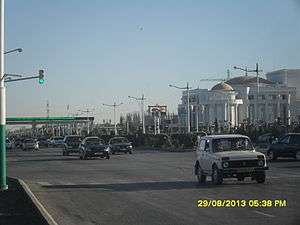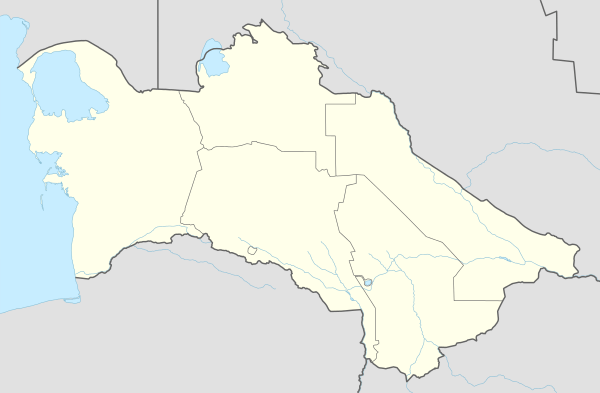Türkmenabat
| Türkmenabat Charjew, Chardzhou | |
|---|---|
 | |
 Türkmenabat Location in Turkmenistan | |
| Coordinates: 39°05′N 63°34′E / 39.083°N 63.567°E | |
| Country |
|
| Province | Lebap Province |
| Elevation | 187 m (614 ft) |
| Population (2009 census)[1] | |
| • Total | 253,000 |
Türkmenabat (Cyrillic Turkmen: Түркменабат, Persian: ترکمن آباد), formerly and since medieval times, Chardzhou (Russian: Чарджоу, Turkmen: Чәрҗев), also spelled Çärjew, Chardjui, Charjou, Chardzhev, Charjev, Chärjew, or Charjew (Persian: چهارجوی for 'four canals'), ancient Amul, is a city in Turkmenistan, capital of Lebap Province. As of 2009, it had a population of approximately 254,000 people (up from 161,000 in the 1989 census).
Geography
Türkmenabat is located at an altitude of 187 m (614 ft) on the banks of the Amu-Darya River, near the border with Uzbekistan. Türkmenabat is at the center of Lebap province, which has borders with three provinces in Turkmenistan: Mary, Ahal and Daşoguz. The province also borders with Uzbekistan and Afghanistan.
Some 70 kilometres (43 miles) south of Türkmenabat in the East Karakum Desert is the Repetek Nature Reserve, famed for its zemzen, or desert crocodiles.
History
Although now a modern industrial city, Türkmenabat has a history of over 2,000 years. In ancient times, it was known as Āmul (to be distinguished from the Iranian city of Amol). The river Amu Darya is said to mean River of Āmul, named after this ancient city. Türkmenabat was the hub in an intersection between 3 paths of the Great Silk Way leading to Bukhara, Khiva and Merv. . For centuries, Āmul was an important town of the relatively backward Uzbek feudal khanate (later emirate) of Bukhara.
When the Russian Empire started annexing Central Asian Turkestan, Āmul was surrendered to Russians by the Bukhara emirate, who later herself would entirely become a vassal of Russia and pledge allegiance to the Russian emperor. The modern city was founded in 1886, when Cossack Russians settled in Uralka in what is now the eastern part of Türkmenabat, naming their settlement New-Chardjuy. The settlement here was necessary to complete the construction of the Trans-Caspian railway.
After the revolution of 1917, when the Bolsheviks came into power in Russia, communists merged former khanates into republics on the basis of nationality. Thus, Türkmenabat (known as Chardjuy at those times) was passed to the newly created Turkmen Soviet Socialist Republic in order to reduce the territory and strength of a highly nationalistic Uzbekistan.
Its role as a railway junction, and the high fertility of the Amu-Darya region, made it the major trade center for agricultural products in the northeast region of the country. The city has food processing, textile (cotton processing and silk) factories. Chardzhou was Turkmenistan's industrial and transport hub during the Soviet period, but most of these related jobs and transport opportunities have been relocated to Ashgabat or closed since Turkmenistan's independence.
Climate
Türkmenabat has a cool desert climate (Köppen climate classification BWk), with cool winters and very hot summers. Rainfall is generally light and erratic, and occurs mainly in the winter and autumn months.
| Climate data for Türkmenabat | |||||||||||||
|---|---|---|---|---|---|---|---|---|---|---|---|---|---|
| Month | Jan | Feb | Mar | Apr | May | Jun | Jul | Aug | Sep | Oct | Nov | Dec | Year |
| Record high °C (°F) | 24.0 (75.2) |
28.4 (83.1) |
33.9 (93) |
40.3 (104.5) |
42.2 (108) |
44.0 (111.2) |
44.9 (112.8) |
43.0 (109.4) |
40.4 (104.7) |
35.6 (96.1) |
31.3 (88.3) |
25.7 (78.3) |
44.9 (112.8) |
| Average high °C (°F) | 6.8 (44.2) |
10.0 (50) |
16.0 (60.8) |
24.4 (75.9) |
30.4 (86.7) |
34.8 (94.6) |
36.4 (97.5) |
34.5 (94.1) |
29.7 (85.5) |
22.6 (72.7) |
15.0 (59) |
8.3 (46.9) |
22.41 (72.33) |
| Daily mean °C (°F) | 1.0 (33.8) |
3.7 (38.7) |
9.2 (48.6) |
17.1 (62.8) |
23.3 (73.9) |
27.6 (81.7) |
29.3 (84.7) |
26.9 (80.4) |
21.2 (70.2) |
13.9 (57) |
7.6 (45.7) |
2.7 (36.9) |
15.29 (59.53) |
| Average low °C (°F) | −3.3 (26.1) |
−1.1 (30) |
3.6 (38.5) |
10.4 (50.7) |
15.7 (60.3) |
19.5 (67.1) |
21.4 (70.5) |
19.0 (66.2) |
13.1 (55.6) |
6.6 (43.9) |
1.7 (35.1) |
−1.8 (28.8) |
8.73 (47.73) |
| Record low °C (°F) | −23.8 (−10.8) |
−22.2 (−8) |
−16.3 (2.7) |
−4.6 (23.7) |
0.8 (33.4) |
9.4 (48.9) |
11.2 (52.2) |
9.1 (48.4) |
2.8 (37) |
−9.5 (14.9) |
−19.8 (−3.6) |
−23.4 (−10.1) |
−23.8 (−10.8) |
| Average precipitation mm (inches) | 19 (0.75) |
17.4 (0.685) |
26.7 (1.051) |
22.4 (0.882) |
10.4 (0.409) |
1.5 (0.059) |
1.0 (0.039) |
0.1 (0.004) |
0.5 (0.02) |
4.6 (0.181) |
9.8 (0.386) |
16.1 (0.634) |
129.5 (5.1) |
| Average precipitation days (≥ 0.1 mm) | 6.3 | 5.8 | 5.6 | 4.7 | 2.0 | 0.5 | 0.2 | 0.3 | 0.2 | 1.5 | 5.2 | 6.3 | 38.6 |
| Average relative humidity (%) | 76.9 | 69.6 | 59.4 | 51.4 | 43.1 | 36.0 | 37.4 | 38.1 | 43.3 | 54.4 | 69.3 | 77.2 | 54.68 |
| Mean monthly sunshine hours | 131.8 | 153.2 | 197.6 | 242.1 | 330.3 | 384.5 | 395.3 | 379.1 | 322.7 | 267.7 | 193.7 | 132.0 | 3,130 |
| Source #1: climatebase.ru[2] | |||||||||||||
| Source #2: NOAA (1961-1990)[3] | |||||||||||||
Demographics
Türkmenabat is unusual in Turkmenistan because it has population which speaks its own dialect. This regional dialect mostly consist of Turkmen language and Uzbek language which has heavily influenced the area's culture and customs.This dialect mostly spoken in Turkmenabat and Northern provinces of Lebap.
Transport

Türkmenabat is connected with the Turkmen capital Ashgabat and Turkmen port city Türkmenbaşy by Turkmenistan Airlines and the M37 highway. Türkmenabat is also connected by train to every province in Turkmenistan.
Culture
Tasinlikler meydanchasy is a park where people celebrate national holidays. Türkmenabat also well known for its bazaars. The largest bazaar is "World bazaar" which is known by the name Dunya bazar. Other well-known bazaars are Gok bazar and Merkezi bazar. People from all around the country come to Türkmenabat in order to purchase local, Chinese, Turkish, Uzbek and Russian goods. Dunya bazar has many sections, including those for jewelry, home appliances, clothes, diary, cars, and other items.
One of the most attractive places in Türkmenabat is Zaton, is an artificial beach, located about 5 kilometres (3.1 mi) from the center of the city. During the whole summer youth gather at 'Zaton' for relaxation and enjoyment.
The youth in Türkmenabat lack many normal opportunities of having fun and enjoying their spare time. They spend their spare time mainly in clubs and pubs, but they do not have any place to meet the world culture. Despite being a city with over 200,000 people, it lacks entertainment facilities such as cinema, a modern theatre, a zoo, or a theme park with newest attractions for children and youth. The only two ex-cinemas have been rented to entrepreneurs and became wed-centers, the place where the wedding ceremonies are being made. The cultural and historical knowledge of the modern youth that don't have the opportunity to study abroad is poor. The city doesn't have modern libraries. The only internet cafes are held by the state, which controls the internet traffic.
Education
Türkmenabat has one state-owned University specializing in teacher training (known in Turkmen as: Seýitnazar Seýdi adyndaky Türkmen Döwlet Mugallymçylyk Instituty'), a medical college, carrier schools, public schools, and specialised arts and sports schools. Until recently, there was a Tutkmenabat Turkmen-Turkish High School which was part of the countrywide network of Turkmen-Turkish schools, and one of the leading schools in the city. It followed a national educational curriculum, where students have a good opportunity to learn English as well as Turkish and Russian languages. Students of this school have attended international Olympiads and gained many medals in different branches of Science and Technology. Students of Turkmen-Turkish Schools are honored as 'Pride of Nation'. As a result of recent changes in education policy, Turkmen-Turkish school in Türkmenabat was turned into a specialised boarding school.
International relations
References
- ↑ Population census 1989, Demoscope Weekly, No. 359-360, 1–18 January 2009 (search for Туркменская ССР) (Russian)
- ↑ "Chardzhou, Turkmenistan". Climatebase.ru. Retrieved 9 February 2013.
- ↑ "Climate Normals for Charjew". National Oceanic and Atmospheric Administration. Retrieved 9 February 2013.
External links
| Wikimedia Commons has media related to Türkmenabat. |
| Wikivoyage has a travel guide for Türkmenabat. |
Coordinates: 39°05′N 63°34′E / 39.083°N 63.567°E